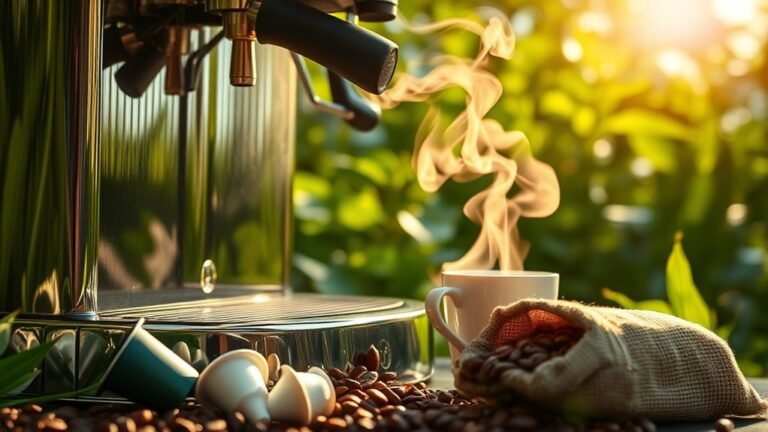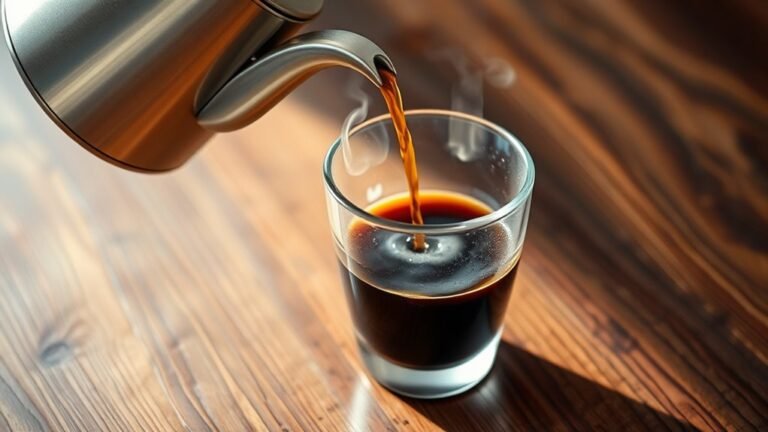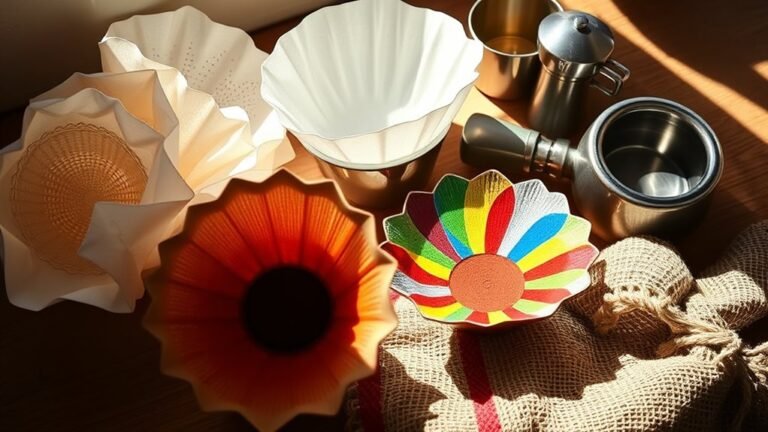Common Coffee Equipment Problems and How to Fix Them
Common coffee equipment problems can disrupt your brew. If your grinder’s clogged, clean it with a soft brush and adjust the grind size. For leaky espresso machines, check for loose fittings and replace worn parts. If your drip coffee pot isn’t brewing, inspect power sources and water lines. Inconsistent temperatures can affect flavor, so monitor your kettle’s heat. Regularly clean your brew basket to prevent bitterness and guarantee quality. Stick around to discover additional solutions.
Clogged Coffee Grinder

One of the most common issues you’ll encounter with your coffee equipment is a clogged coffee grinder. Regular grinder maintenance is essential to guarantee peak performance. When grind size isn’t consistent, it can lead to clogs, resulting in uneven extraction and a bitter taste. To prevent this, clean your grinder frequently, removing coffee residue and oils that accumulate over time. Check the grind size settings; using a coarser setting can help reduce clogging, especially with oily beans. If you notice a reduction in grinding efficiency, it’s time for a thorough cleaning. Disassemble your grinder according to the manufacturer’s instructions and use a soft brush to clear any blockages. By staying proactive, you’ll maintain the quality of your coffee and enjoy a consistently great brew.
Leaky Espresso Machine
When your espresso machine starts leaking, it can be frustrating, especially when you rely on it for your daily brew. Espresso leaks often stem from improper machine maintenance or worn-out components. To tackle the issue, consider these steps:
Experiencing leaks from your espresso machine can be annoying, especially if it’s essential for your daily routine.
- Check and tighten any loose fittings or connections.
- Inspect the group head gasket for wear and replace it if necessary.
- Examine the water tank for cracks or damage.
- Clean the drip tray to prevent overflow.
Drip Coffee Pot Not Brewing
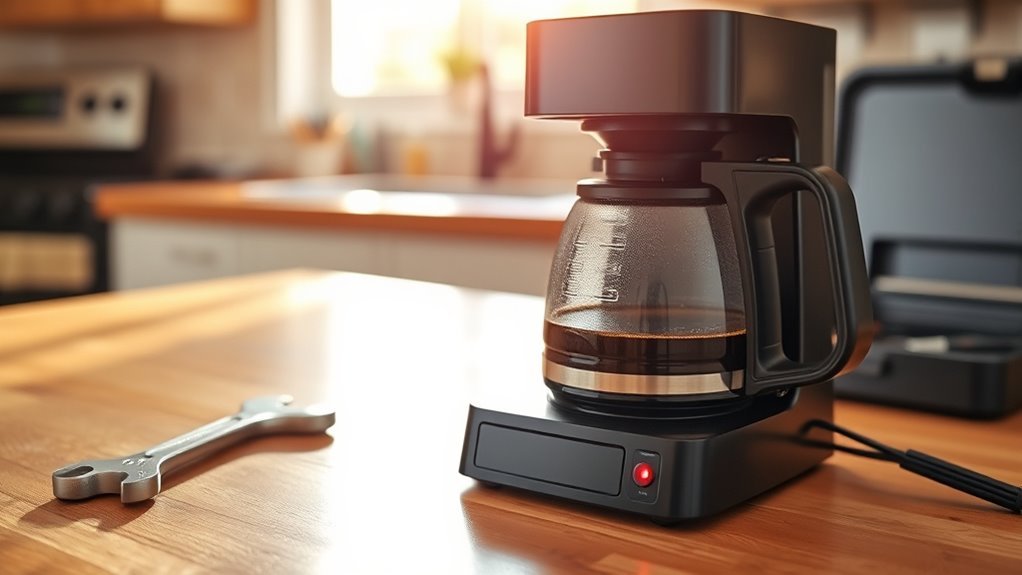
If your drip coffee pot isn’t brewing, start by checking the power source to confirm it’s plugged in and functional. Next, inspect for clogged water lines that could be obstructing the flow of water. Finally, verify that the brew settings are configured correctly, as incorrect settings can prevent the machine from operating.
Power Source Issues
Although your drip coffee pot may seem ready to brew, power source issues can prevent it from functioning properly. First, check if the appliance is plugged into a faulty outlet, as this can disrupt power flow. Power surges may also damage the internal components, leading to malfunctions. Here are a few steps to troubleshoot:
- Test the outlet with another device to verify it’s working.
- Inspect the power cord for any visible damage.
- Reset your home’s circuit breaker to eliminate any interruptions.
- Consider using a surge protector to safeguard against future power surges.
Clogged Water Lines
Clogged water lines are a common culprit behind a drip coffee pot that refuses to brew. If you’re facing this issue, it’s essential to perform regular water line maintenance and apply effective descaling techniques. Calcium buildup can obstruct the flow, leading to brewing failures.
Here’s a quick reference table to assist you:
| Problem | Solution | Frequency |
|---|---|---|
| Clogged Lines | Use a descaling solution | Every 3-6 months |
| Slow Brewing | Clean water reservoir | Monthly |
| No Water Flow | Inspect and replace filters | As needed |
| Unusual Noises | Check for blockages | Monthly |
Incorrect Brew Settings
Have you double-checked your brew settings? If your drip coffee pot isn’t brewing, it could be due to incorrect configurations. Guaranteeing ideal brew settings is essential for the perfect cup of coffee. Here are a few things to verify:
- Brew Ratio: Check your coffee-to-water ratio; a common guideline is 1:15 for balanced flavor.
- Grind Size: Use a medium grind; too fine can clog filters, while too coarse may under-extract.
- Water Temperature: Ideal brewing temperature is between 195°F to 205°F for maximum extraction.
- Brewing Time: Make sure your pot is set to brew for the recommended duration, typically 4-6 minutes.
Inconsistent Water Temperature

When brewing coffee, the importance of consistent water temperature cannot be overstated, as it directly affects extraction and flavor profile. If you’re experiencing fluctuations in water temperature, it can lead to brewing inconsistencies, resulting in weak or overly bitter coffee. To address this, first check your equipment. Verify that your kettle or coffee maker is functioning properly and calibrated. If you’re using a manual method, maintain a steady heat source. Using an immersion circulator or thermometer can help you monitor and stabilize the water temperature throughout the brewing process. Remember, ideal water temperature for coffee extraction is typically between 195°F and 205°F. Consistent water temperature will enhance your brewing consistency, leading to a more satisfying cup every time.
Burnt Coffee Taste
If you’re experiencing a burnt coffee taste, it could stem from several factors. Overheating brewing temperatures can scorch the coffee, while stale beans may contribute to undesirable flavors. Additionally, dirty equipment can leave residue that negatively impacts the taste of your brew.
Overheating Brewing Temperature
Although brewing coffee at the correct temperature is essential for ideal flavor extraction, overheating can lead to a burnt taste that diminishes the overall experience. To maintain brewing balance and prevent this issue, you need effective temperature control. Here are some tips to guarantee your coffee doesn’t taste burnt:
- Use a thermometer to monitor water temperature.
- Opt for equipment with built-in temperature regulation.
- Experiment with brew times to find the sweet spot.
- Clean your coffee maker regularly to avoid buildup that can affect heating.
Stale Coffee Beans
Stale coffee beans are a common culprit behind that unpleasant burnt taste in your cup. Over time, beans lose their essential oils and flavor compounds, leading to a subpar brew. To guarantee freshness, look for indicators like roast date and aroma. Ideally, you should consume beans within two weeks of roasting. Proper storage is crucial; use airtight storage containers to minimize exposure to air, light, and moisture. Avoid keeping your beans in the fridge or freezer, as temperature fluctuations can degrade quality. Instead, store them in a cool, dark place. When you prioritize freshness, you’ll experience a more vibrant and rich flavor profile, allowing you to enjoy your coffee to the fullest. Don’t let stale beans ruin your experience!
Dirty Equipment Residue
Even with fresh coffee beans, the taste of your brew can be compromised by dirty equipment residue. If you’re experiencing a burnt coffee taste, it’s likely due to the buildup in your coffee maker. Regular cleaning is essential for peak flavor. Here are some effective equipment maintenance tips and residue removal techniques:
- Clean your coffee maker monthly with a vinegar solution to dissolve oils and residue.
- Use a soft brush to scrub the grinder and remove any trapped grounds.
- Rinse and dry components like filters and carafes thoroughly to prevent buildup.
- Run water through your machine after each use to minimize residue accumulation.
Faulty Coffee Maker Power Supply
One of the most common issues with coffee makers is a faulty power supply, which can prevent your machine from functioning correctly. If you’re facing power issues, check the following:
| Problem | Possible Cause | Solution |
|---|---|---|
| No power | Power cord damage | Inspect and replace cord |
| Machine won’t brew | Faulty wiring | Check internal wiring |
| Intermittent power | Loose connections | Tighten all connections |
Ensure your coffee maker is plugged into a functioning outlet. If problems persist, inspect for faulty wiring inside the machine. Remember, dealing with electrical components can be risky; if you’re unsure, consider consulting a professional for repairs. Your coffee freedom shouldn’t be compromised by power issues!
Dirty Brew Basket
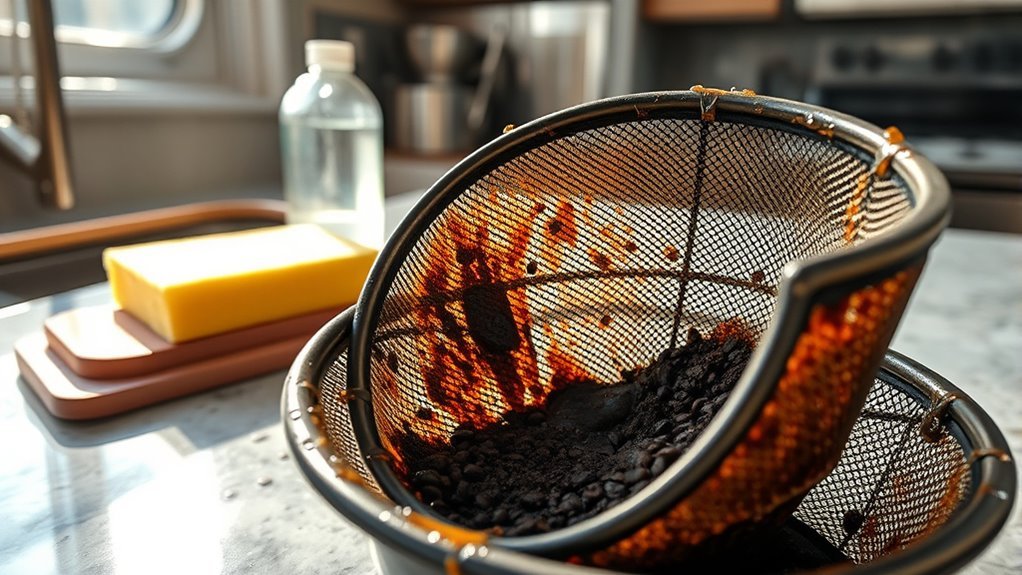
After addressing power supply issues, another common problem that can affect your coffee maker’s performance is a dirty brew basket. Regular brew basket maintenance is essential for ideal flavor extraction. If you notice bitter or off-tasting coffee, it’s time to clean your brew basket. Here are some tips:
A dirty brew basket can lead to bitter coffee; regular cleaning is vital for optimal flavor extraction.
- Use a mild vinegar solution to soak the basket.
- Rinse thoroughly to eliminate any residue.
- Consider switching coffee filter types, such as paper or reusable, based on your flavor preference.
- Clean the brew basket after every use to prevent buildup.
Steam Wand Not Frothing
If your steam wand isn’t frothing as it should, it can greatly impact your ability to create the perfect espresso-based drinks. First, check for any clogs in the steam wand; mineral buildup can obstruct airflow. Regular steam wand maintenance is essential—clean it after each use to prevent residue buildup. Make sure the steam pressure is adequate; low pressure may hinder frothing capabilities. Additionally, refine your frothing techniques; positioning the wand at an angle and submerging it just below the milk’s surface can create a whirlpool effect, enhancing froth quality. If problems persist, inspect the steam valve for any damage or wear. By addressing these factors, you’ll restore your steam wand’s frothing prowess and enjoy barista-quality drinks at home.
Coffee Grounds in Your Cup
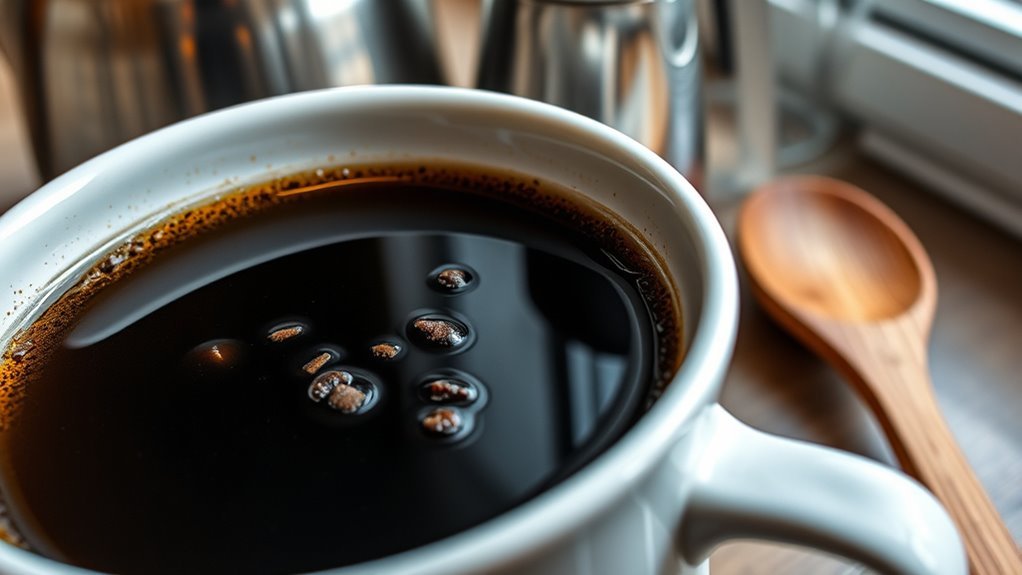
Even with a perfectly frothing steam wand, encountering coffee grounds in your cup can be frustrating and detract from your brewing experience. This issue often stems from improper coffee grind size or a flawed brewing technique. Here are some common causes and solutions:
- Incorrect Grind Size: Too coarse a grind can let grounds pass through filters.
- Clogged Filter: A dirty or damaged filter won’t properly catch grounds.
- Inadequate Brewing Time: Insufficient extraction can lead to unfiltered grounds.
- Equipment Maintenance: Regular cleaning guarantees peak performance.
Frequently Asked Questions
How Often Should I Clean My Coffee Equipment?
You should clean your coffee equipment regularly to guarantee peak performance and taste. A good rule of thumb is to perform a deep clean every month, while daily maintenance, like rinsing and wiping down surfaces, is essential. This cleaning frequency helps prevent residue buildup and maintains equipment longevity. By prioritizing equipment maintenance, you’ll enjoy a consistently delicious cup of coffee and prolong the lifespan of your gear, allowing for a more enjoyable brewing experience.
What Type of Water Is Best for Brewing Coffee?
When you brew coffee, the type of water you use can make a surprising difference. Ideally, you want water with moderate hardness and balanced mineral content. Too soft or too hard water can lead to bland flavors or damage your equipment. If you’re using tap water, check its mineral levels; filtered or bottled water often works best. Remember, the right water enhances extraction, giving you that perfect cup you crave every morning.
Can Stale Coffee Beans Affect My Equipment?
Yes, stale coffee beans can negatively impact your equipment performance. When beans lose freshness, they might produce excessive oils and residues, leading to buildup in your grinder and brewer. This can hinder the extraction process, affecting the flavor of your coffee and potentially causing clogs. To maintain peak performance, it’s essential to use fresh beans and regularly clean your equipment. Freshness guarantees better flavor and prolongs the life of your coffee gear.
How Do I Store Coffee Beans Properly?
Imagine your coffee beans as precious gems, needing a secure vault. To store them properly, invest in an airtight bean container; this shields against oxygen, light, and moisture. Use storage techniques like keeping your container in a cool, dark place, away from heat sources. Avoid the fridge, as it can introduce humidity. By doing this, you’ll preserve their freshness and flavor, ensuring each cup is a delightful experience.
Should I Use Filtered or Tap Water for Brewing?
When brewing coffee, you should consider using filtered water over tap water. Filtered water benefits include removing impurities and chlorine, which can alter your coffee’s flavor profile. Tap water drawbacks often involve unwanted minerals and chemicals that might result in a less enjoyable cup. By opting for filtered water, you’ll enhance the clarity and richness of your brew, allowing the coffee’s true flavors to shine through, ultimately providing a more satisfying experience.


